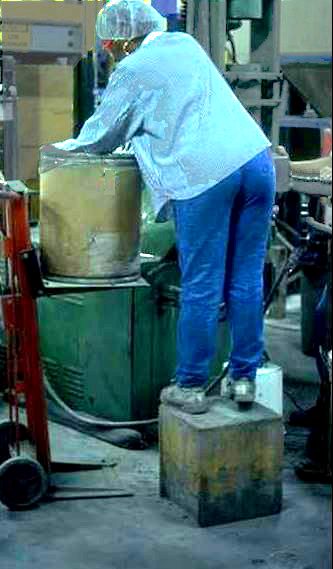 However, the effectiveness of the ideas depend on the circumstances in each workplace. It is not possible in a general setting like this to anticipate all variables in every workplace, and consequently, there are probably exceptions to every general statement.The information on this site has been gathered over 35 years as part of an ergonomics consulting practice for general industry, made available here for educational purposes. All of the solutions provided on this site have been used in one instance or another as practical resolution to various ergonomics issues.
However, the effectiveness of the ideas depend on the circumstances in each workplace. It is not possible in a general setting like this to anticipate all variables in every workplace, and consequently, there are probably exceptions to every general statement.The information on this site has been gathered over 35 years as part of an ergonomics consulting practice for general industry, made available here for educational purposes. All of the solutions provided on this site have been used in one instance or another as practical resolution to various ergonomics issues.
Your situation may involve factors that are different from those in the examples, so you must use judgment and consider potentially unanticipated effects. You must understand the underlying principles of ergonomics to implement solutions optimally. No website can be a substitute for an evaluation by qualified expert. When in doubt, get assistance. (See also Common Errors.)
Interpretation of Ergonomics
Keep in mind the following:
- Anything that improves compatibility of a task for humans is “ergonomic” by definition. The improvement does not necessarily need to have been labeled “ergonomic” by anyone.
- Conversely, any standard “ergonomic” device that is used incorrectly may not be ergonomic at all and it may even make a problem worse.
- The term “ergonomic” is best understood as a comparison between two situations rather than an absolute descriptor. For example, a metal folding chair is ergonomic compared to sitting on the floor, even though an adjustable chair with good cushioning is considerably better.
Principles of Ergonomics
You must understand the underlying principles of ergonomics to implement solutions optimally. Keep these principles in mind while you consider the various options for improvement. The principles are briefly outlined on this site and are described in more detail in books and training materials.
“Solution” vs. “Improvement”
The term “solution” is used on this site because it is a commonly used term in industry in this context. However, the term does not imply that any particular concept will correct any problem completely nor that a total resolution is even possible.
The term “improvement” is generally better, since it doesn’t imply that the result is perfect and permanent. However, “improvement” can be somewhat cumbersome when writing, and consequently on this site, the two terms are used as synonyms.
Options for Improvement
Whenever possible, each page on this site provides an array of options, ranging from low-cost to high-end alternatives. There are a number of reasons for doing so:
- Different circumstances may require different approaches, including the budget available for making improvements and the severity of the problem being addressed.
- Often, the examples that are provided on this site may need to be modified to fit particular circumstances. Providing a range of options helps users identify ways to adapt ideas for their specific needs.
- Part of the purpose of this website is to help you to think, be creative, and identify approaches that will work for you. Seeing an array of options and ideas can help this process.
- Developing a list of options can be particularly helpful in finding simpler and less expensive approaches
- Finally, there are undoubtedly additional solutions and strategies for improvement that are not presented here. Providing multiple options helps users to anticipate that there may be yet additional ideas.
Continuous Improvement
The proper context for interpreting the information on this site is “continuous improvement,” as the phrase is commonly used in industry. It is normally very difficult to create perfect jobs, if indeed any exist.
Attempts to resolve every possible issue to create the ergonomically perfect task usually become stymied, with the result that nothing is ever accomplished. Usually, it is better to make some improvements now and return later to for another round of changes. Focus on progress, not perfection, in this context.
Note especially that many of the photos do not show a perfect solution to every possible problem in the picture. The objective in developing this website has been to provide guidance on how jobs can be improved one way or another and for the reader to then adapt these ideas for specific application, taking into account the special circumstances of each application.
